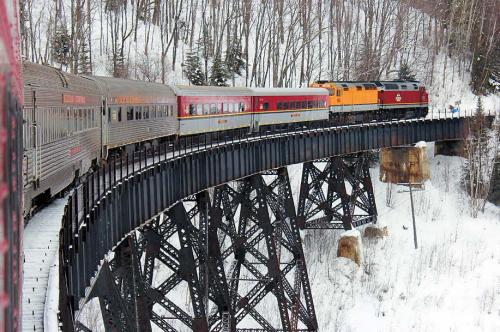Agawa Canyon Snow Train takes a round-trip journey to stillness
By Korea HeraldPublished : March 2, 2012 - 18:25
AGAWA CANYON, Ontario, Canada ― There are no animals, no birds, not one moving creature, except for a man on a lake who raises his hand as we pass. It is overcast. Sky the color of cotton wool muffles the harsh rocky landscape; the snow and hills blend into a black-and-white panorama dotted with the drab loden of the pines. Snow falls in fits and starts. It is already more than 2 feet deep. Let spring come somewhere else; winter has settled here, as always.
Last year, the Agawa Canyon Snow Train did not run. This year, it has $11 million worth of new equipment, upgraded coaches and splendid new burgundy paint. It has a warm dining car with good service and hearty food. It is running each Saturday through March 10.
The question is: Does anyone have the patience to ride the Snow Train anymore?
“We used to do 25 coaches, two dining cars, two dome cars and five or six engines; we were a mile long,” says Craig (Smitty) Smith of EJM Catering, who has worked the train for 17 years. “We would have 1,600 to 1,800 passengers a day. Then, along came 9/11.”
That’s when everything changed. The Agawa Canyon tour trains, which run in winter, summer and fall, saw business plummet when passports became a requirement to cross the U.S.-Canada border. Gas prices rose and Michigan’s economy tanked, damaging the train’s busiest source of customers. The value of the U.S. dollar shrank against the Canadian dollar.
Then, a whole generation of travelers who thought Agawa Canyon was the most exotic place in the world passed on, leaving restless younger folks who demand active, not passive experiences.
Now the Snow Train runs just six coaches, one dining car and two engines. This day, it has about 100 passengers spread through three of the cars. The other cars are empty.
Its route? Chug from downtown Sault Ste. Marie, Ontario, to scenic Agawa Canyon 114 miles north, then return.
In summer, passengers can hike and picnic in the canyon. But in winter, they must stay on board the train the whole trip ― nine hours straight. There’s no opening the windows. No smoking. No cell phone service.
And that’s exactly what railroad fans love about the Snow Train. They love the silence. They love the feeling of being far, far away in an earlier time. They love the stubborn simplicity of it all.
Last year, the Agawa Canyon Snow Train did not run. This year, it has $11 million worth of new equipment, upgraded coaches and splendid new burgundy paint. It has a warm dining car with good service and hearty food. It is running each Saturday through March 10.
The question is: Does anyone have the patience to ride the Snow Train anymore?
“We used to do 25 coaches, two dining cars, two dome cars and five or six engines; we were a mile long,” says Craig (Smitty) Smith of EJM Catering, who has worked the train for 17 years. “We would have 1,600 to 1,800 passengers a day. Then, along came 9/11.”
That’s when everything changed. The Agawa Canyon tour trains, which run in winter, summer and fall, saw business plummet when passports became a requirement to cross the U.S.-Canada border. Gas prices rose and Michigan’s economy tanked, damaging the train’s busiest source of customers. The value of the U.S. dollar shrank against the Canadian dollar.
Then, a whole generation of travelers who thought Agawa Canyon was the most exotic place in the world passed on, leaving restless younger folks who demand active, not passive experiences.
Now the Snow Train runs just six coaches, one dining car and two engines. This day, it has about 100 passengers spread through three of the cars. The other cars are empty.
Its route? Chug from downtown Sault Ste. Marie, Ontario, to scenic Agawa Canyon 114 miles north, then return.
In summer, passengers can hike and picnic in the canyon. But in winter, they must stay on board the train the whole trip ― nine hours straight. There’s no opening the windows. No smoking. No cell phone service.
And that’s exactly what railroad fans love about the Snow Train. They love the silence. They love the feeling of being far, far away in an earlier time. They love the stubborn simplicity of it all.

“Years ago, I came on this train with my parents. Then, when Suzanne and I started dating, we came here again. Now, we’ve brought our daughter,” says David Bergeson of Flat Rock, Mich., who wears a sweatshirt with a picture of a train on it, as do his wife, Suzanne, and 5-year-old daughter, Barbara. They ride trains all over the country.
Even Bergeson, 45, wasn’t sure whether the Snow Train was still in business, and he was thrilled to find it was.
“It’s a combination of a weekend getaway in the middle of winter and a chance to see some snow since we don’t have any in Detroit,” he says.
A bit of history. There has been a railway up here since 1899 for freight and passengers. The regular “Hearst” train (also called the Algoma Central Railway Tour of the Line) runs 296 miles from busy Sault Ste. Marie, Ontario, (population 75,000) up to tiny Hearst, Ontario (population 5,000). Many fishing camps and cottages lie along the remote route, so passengers can flag down the train to stop at any point.
Sharing the rails is the more famous Agawa Canyon tour train, which is called the Snow Train in the winter. Since 1972, the tour train has carried more than 3 million passengers to the canyon and back.
Two years ago, owner Canadian National Railway decided the 1940s equipment was too decrepit. It bought a 1968-era ski train from Colorado with 16 coaches and three locomotives and sent most of it away to be rehabbed and repainted. The new tour train has enlarged windows with tinted glass on nine of the 14 coaches and new carpet and seating. It has new GPS-tripped narration explaining the history of the line and the features of the stern Algoma region of northern Ontario.
Coaches also have new flat-screen TVs to show the engineer’s view ahead of the train, a feature available only in summer and fall (last summer, some lucky passengers saw a moose).
In winter, the view out the side windows is what you will remember.
Approaching Agawa Canyon, the train has been running downhill for 12 miles. The tracks are smooth, with their good Canadian maintenance.
Way up here, jutting bedrock walls and canyons thrust up inland of Lake Superior. Deep glacial lakes nestle in the valleys, covered by ice and snow. In a few places, the hills drop away long enough to show a peek-a-boo Lake Superior in the distance, a grand, gray sight.
Up here, trees and rocks crowd the rails. The train passes giant boulders topped with so much snow they look like frosted cupcakes. Waterfalls on the canyon walls are stopped mid stream. They are nature’s ice sculptures laced with honey-colored tannin.
Finally, the Snow Train stops. We’re here. The two engines that are facing back-to-back in the front of the train are unhooked, run forward, then onto a parallel track. They are run beside the train and rehooked to what had been the back. The red engine that was facing forward on the way up is now facing backward. The yellow engine that was facing backward on the way up is now leading the train home.
That is really the high point of the trip.
But I don’t think it is enough.
A train lover would argue that the lesson of the Snow Train, for those patient enough to hear it, is that Canada is a vast, vast land filled mostly with wilderness, and that a chance to be a tiny dot on a little train chugging up the line for one day shows you how insignificant you really are. That is not exactly an “all about me” experience. It’s more of an existential one.
But I would like to see passengers get a chance to step off the Snow Train in Agawa Canyon. In summer, travelers can hike and picnic in the canyon for 1 hours. That is good, because when you’ve been 4 hours on a train, you need to feel as if you’ve arrived at a destination. You need to do something. You need to breathe.
Yes, winter is tough in the canyon. Yes, there’s nobody to shovel out there. But there has got to be a way at least to give the passive passengers some bracing fresh air. Open a window. Offer snowshoeing. At least clear a small area so passengers can set foot in Agawa Canyon, a destination they’ve traveled so far to see.
The main activity I saw passengers do on the Snow Train was sleep.
By Ellen Creager
(Detroit Free Press)
(MCT Information Services)
-
Articles by Korea Herald


![[Exclusive] Korean military set to ban iPhones over 'security' concerns](http://res.heraldm.com/phpwas/restmb_idxmake.php?idx=644&simg=/content/image/2024/04/23/20240423050599_0.jpg&u=20240423183955)
![[AtoZ into Korean mind] Humor in Korea: Navigating the line between what's funny and not](http://res.heraldm.com/phpwas/restmb_idxmake.php?idx=644&simg=/content/image/2024/04/22/20240422050642_0.jpg&u=)


![[Graphic News] 77% of young Koreans still financially dependent](http://res.heraldm.com/phpwas/restmb_idxmake.php?idx=644&simg=/content/image/2024/04/22/20240422050762_0.gif&u=)












![[Today’s K-pop] Ateez confirms US tour details](http://res.heraldm.com/phpwas/restmb_idxmake.php?idx=642&simg=/content/image/2024/04/23/20240423050700_0.jpg&u=)